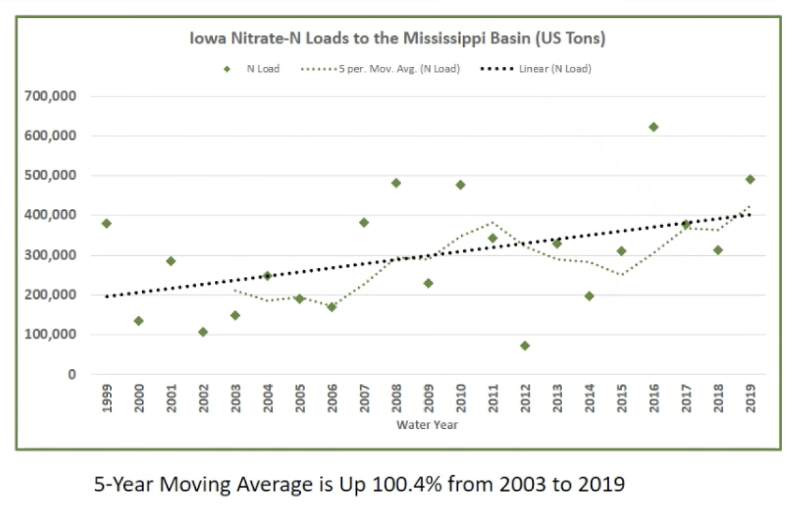by Jared Strong, Iowa Capital Dispatch
March 27, 2024
A fertilizer spill this month in southwest Iowa killed nearly all the fish in a 60-mile stretch of river with an estimated death toll of more than 750,000, according to Iowa and... more

Iowa will never achieve its goal to reduce nitrate runoff from Iowa farm fields relying only on voluntary actions of farm operators, according to a hydrologist who has done extensive research on the state's waterways and water quality.
The state has not only has failed to achieve its goal to reduce nitrogen runoff by 45 percent over the past eight years, the 5-year average of nitrate flowing into the Mississippi River has increased, up more than 100 percent between 2003 and 2019, according to Larry Weber, Ph.D, a research engineer with the University of Iowa's IIHR-Hydroscience and Engineering Department.
The only way the state can hope to actually achieve nutrient reduction, Weber told a recent webinar on water quality, is regulation.
"The state needs to replace one of the "R's" in its Nutrient Reduction Strategy with a new "R" called 'regulation,' Weber said during the presentation: "The Iowa Watershed Approach: A Vision for a More Resilient Iowa."
"Relying on voluntary adoption (of nutrient reduction practices) will never get us there," he said.
Just months ago, Iowa Dept. of Agriculture and Land Stewardship Secretary Michael Naig boasted that the state was making "clear and significant strides" reducing chemical runoff from farms fields into state streams, rivers and lakes.
The Iowa Farm Bureau, the Iowa Department of Agriculture and Land Stewardship (IDALS) and Iowa State University researchers have held up the Nutrient Reduction Strategy as the best path forward to lower farm chemical runoff that causes algae growth in rivers and lakes and contributes to the "dead zone" in the Gulf of Mexico where marine life cannot survive.
That strategy relies on voluntary actions by farm operators to add conservation practices like cover crops, bio-reactors, grassed waterways, wetlands and increasing conservation reserve acres.
The farm bureau, in particular, has fueled the narrative that great progress is being made by voluntary projects undertaken by farm operators implementing conservation practices to filter out nitrogen and phosphorus from field runoff.
However, even with additional funds allocated by the state to help pay for conservation projects, the number and scope of such measures falls far short of what is needed to significantly impact runoff from Iowa's 33 million acres of crop land.

Research also shows the strong connection between farm field tile drainage in worsening the pollution of streams and rivers.
Water from farm tiles (pipes buried in fields to siphon off surface water) comprises anywhere from 35 to 65 percent of total monthly streamflows during the spring, summer and fall months, according to researchers. And, during dry years, water from tile runoff can account for more than 80 percent of the annual streamflow.
by Jared Strong, Iowa Capital Dispatch
March 27, 2024
A fertilizer spill this month in southwest Iowa killed nearly all the fish in a 60-mile stretch of river with an estimated death toll of more than 750,000, according to Iowa and... more
by Robin Opsahl, Iowa Capital Dispatch
March 25, 2024
The Iowa Senate on Monday sent a bill to the governor’s desk restricting stormwater and topsoil regulations, a measure Democrats say unfairly limits local control.
The Senate... more
Iowa Capital Dispatch
March 11, 2024
The Iowa House passed legislation Monday on local storm water and top soil regulation after the same bill failed last week.
... more
An India online media company, Quint Digital Limited of Delhi, has purchased a 10 percent stake in Lee Enterprises, Inc., owner of the Quad City Times, the Dispatch/Argus and more than 70 other media properties.
Quint Digital and three of its owners, Raghav Bahl, Ritu Kapur and Vidar Bahl... more
Powered by Drupal | Skifi theme by Worthapost | Customized by GAH, Inc.

